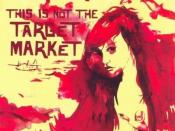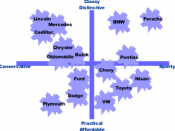Thorr Motorcycle Company is faced with three issues concerning the future of their signature 1500cc motorcycle. At issue is decreasing sales, positioning in the market place, and success of their marketing plan. Each situation is described offering possible solutions, and results or recommendations are discussed. Finally a discussion of differentiation, positioning, and product life cycle will be discussed.
Thorr Motorcycles, Inc. is a $5 billion company. They manufacture a range of motorcycles and produce more than 200,000 units per year. Thorr Motorcycles has additional license programs such as T-Shirts, motorcycle shoes, small leather goods, toys, and other consumer items. The sales of Thorr's existing product, Cruiser Thorr, are decreasing. Their service includes dealer training, dealer software packages, motorcycle rental, and riding training. The age group of target customers has always been 35 to 50 years old. However, as the company grows, they are no longer interested in the lifestyle that Cruiser Thorr symbolizes.
The new target will include the younger customers preferring low-cost motorcycles. Thorr is a high priced product and younger people do not have the large disposable income necessary to support the brand.
The company has a high-brand image manufacturing high-end motorcycles and currently owns approximately forty percent of the market share. However, Thorr is losing market share and needs to reverse the trend with a new marketing plan (Apollo Group, 2004). This will be accomplished by using a perceptual map.
A perceptual map, which is a visual representation of the customer's perception of the brand helps in differentiating a company's marketing from that of its competitors. A perceptual map can have several parameters, which may overlap in their descriptions. These overlapping parameters are the superficial attributes of the product, and several of them often define a product's fundamental parameters" (Apollo Group, 2004).
The motorcycle industry is growing annually, but sales at Thorr Motorcycle's Cruiser Thorr (priced at $25,000) is decreasing. This is because its target customer (age group 35-50 years) are growing older and are no longer interested in that kind of lifestyle. Other factors are younger customers (age group 21-35 years) that prefer lower cost motorcycles, because they do not have large disposable income. The competitors are also getting into Cruiser Thorr's market shareThe first step in the simulation is to determine the positioning strategy of Thorr using a perceptual map. There are four parameters that must be selected in the simulation. Four areas that were chosen are lifestyle, quality engineering, price, and services. As Thorr's target market gets older and lifestyle image is not as important to them as in their earlier years, the company should focus on this area to revise interest. Lifestyle image is important because it influences customers to buy into image rather than attributes. Lifestyle image plays the most important role in the motorcycle industry. Quality engineering covers attributes such as product design, styling, and engine capacity. Market research showed engine capacity was an important attribute among Thorr's competition as well and may help to increase their motorcycle's image and attract the younger age group. Price influences purchase decisions because the amount of disposable income available. "A high price is directly proportional to a high image" (Apollo Group, 2004). People will pay more for a similar product sold at lower price because it is proportionate to a higher image. Lowering the price of the motorcycle to attract the younger market would have the adverse affect of lowering the image alienating the 35 to 50 year old market. Services are the final area of focus and are just as important as the others because good service goes a long way of retaining customers and word of mouth referrals.
The second step in the simulation is to decide whether you should launch a new product line or reposition the CruiserThorr brand. The option of launching a new motorcycle that RRoth targets a younger audience was given along with decisions on features and prices. The new product line is one that would honor the image of the company and while targeting younger customers. The price range chose was $13,000-$15,000. Previous surveys indicated that younger customers prefer a low-price motorcycle. Thorr was given a $13 million budget in order to implement the marketing plan. The method of promotion selected was mainly through Hollywood Films and celebrity endorsements to target the younger generation. Thorr would be available for purchase from dealers, distributors, and the Internet. Thorr will also sponsor events such as Daytona, offering free test rides, hiring celebrities for endorsements, and providing giveaway merchandise was picked for promoting to the younger target motorcycle consumers.
The third step in the simulation was to ascertain whether your marketing plan was successful after having been implemented for a year by interpreting data from customer surveys and then plot a perceptual map for both CruiserThorr and RRoth. An important thing to remember is that perceptual mapping is based on how management views the brand and may not properly reflect the way the customers view the brand. (Apollo Group, 2004). The research data was correctly interpreted. A value of nine was assigned to lifestyle image. According to research, Thorr's lifestyle image maintained a high image by improving services. A value of eight was assigned to quality engineering. Market research indicated that quality engineering was high. A value of seven was assigned to price. However, assigning a value of four or five would have been more appropriate. Price was perceived negatively because Cruiser Thorr's is an expensive motorcycle. A value of seven was assigned to services. The previous services were not adequate. To improve this, services such as dealer training, financial services, customization options were successfully introduced. "This greatly affected customer response to the survey" (Apollo Group, 2004).
The relationship between differentiation and positioning of products or services can be changing things about a product or service or by making a difference between similar products and positioning to attract different market share. "Positioning refers to how customers think about proposed or present brands in a market" (Perreault & McCarthy, 2004, pg. 82). Positioning and differentiation was used by Thorr in marketing the Cruiser and creating the RRoth. Things to consider when differentiation and position might be branding, product attributes, consumer adoptions, and other items such as price and quality. Repositioning the product in the simulation was a good decision. Thorr motorcycles made their brand more attractive by offering a product that suited a younger population. However, Thorr did not abandon their original product or lifestyle image, but created a new product and image in order to gain younger market. Also, the perpetual map exercise helped identify the areas that were making Thorr's competitors successful and made sense to reposition based on the information.
The impact of product life cycle on marketing requires marketing plans to always be adjusted for changes based on the products position and time in the cycle itself. The cycle is divided into four stages; market introduction, market growth, market maturity, and sales decline (Perreault et al, 2004). The impact of the life cycle on Thorr's motorcycle forced the company to make changes in their marketing in order to reverse sales declines. Although the company introduced a motorcycle appealing to a certain lifestyle, the company had to make changes to keep the current target market or select another target market group such as the 21 to35 year olds. If the company wanted to continue growing, decisions were made to compete with other competitors. Since the company had been in business for a while, maturity of the product has to be addressed such as pricing and product modification. Part of the life cycle is decline and the company had to decide to phase out or maintain its current model of motorcycle. If a company does not recognize product life cycles, they will surely be left behind their competitors.
In conclusion, the simulation provided an opportunity to actually see a perceptual map put to use and how it can help a company with marketing plans. The simulation also helped to provide a better understanding on how important market research can be used as well for the benefit of the company. Finally, my understanding of differentiation and positioning is clearer and also how the life cycle could make or break a company.
Resources: Perreault, W. D. & McCarthy, E. J. (2004). Basic Marketing: A Global-Managerial Approach. The McGraw-Hill Companies. Retrieved March 25, 2008, from https://mycampus.phoenix.edu/secure/resource/resource.aspUniversity of Phoenix, (2007) Simulation, Using Perceptual Maps in Marketing, retrieved on March, 24 2008 from:https://mycampus.phoenix.edu


